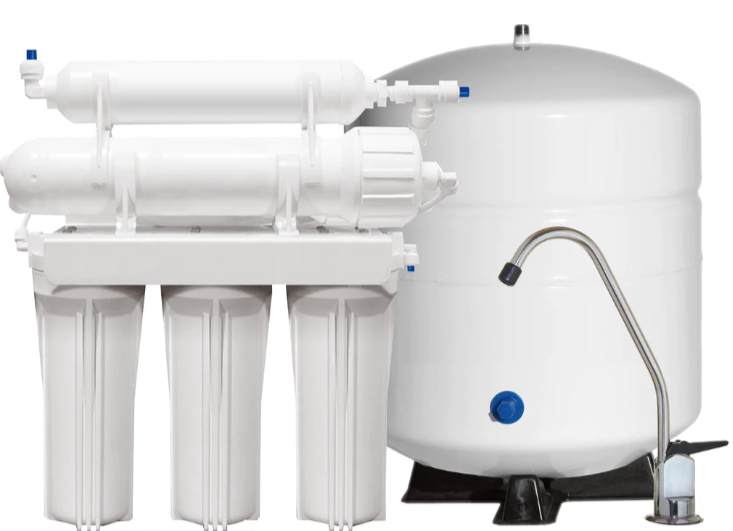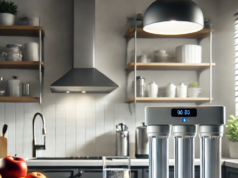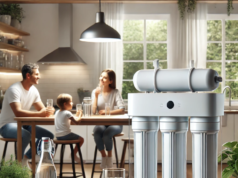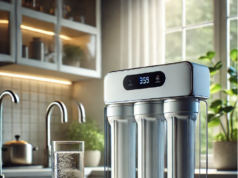Contents
How Reverse Osmosis Filtration Works to Purify Your Water
Reverse osmosis (RO) is a water purification process that utilizes a semipermeable membrane to remove impurities from drinking water. The process involves applying pressure to push water through a membrane that traps contaminants, allowing only pure water molecules to pass through. RO filtration systems are popular for home water treatment because they effectively remove harmful minerals, chemicals, and impurities from tap water.
The RO membrane filters out a range of impurities, including dissolved solids, bacteria, viruses, and other contaminants, while allowing clean water molecules to pass through. The filtration process works by applying high pressure to the water on one side of the membrane, forcing it through tiny pores in the membrane, and trapping the contaminants.
The RO filtration system typically has several stages, including pre-filtration, the reverse osmosis process where water is pushed through the membrane, and post-filtration, where the water is further purified and cleaned. The system may also include a storage tank to hold the purified water and a final polishing stage to ensure the best quality water.
Overall, reverse osmosis is a highly effective water purification method that ensures clean and safe drinking water. As a homeowner, investing in an RO filtration system is a smart way to protect your family’s health and wellbeing.
💧 = Use the coupon code SALEG3P800 to save $150 OFF on the 800GPD Tankless RO System with UV Sterilizing Light – Waterdrop G3P800 = 💧
What is Reverse Osmosis Filtration?
Reverse Osmosis (RO) filtration is a water treatment process that uses a semipermeable membrane to remove salt, chemicals, minerals, and other impurities from water.
How Does Reverse Osmosis Filtration Work?
The RO process works by forcing water under high pressure through a semipermeable membrane that filters out contaminants. The semipermeable membrane has tiny pores that only allow water molecules to pass through, while blocking larger molecules like salt and other impurities.
As the water passes through the membrane, contaminants are separated and flushed out, leaving behind clean and purified water.
Stages of Reverse Osmosis Filtration
Stage 1: Pre-Filtration
Before the water reaches the semipermeable membrane, it goes through a series of pre-filters that remove larger impurities like sediments and chlorine, protecting the membrane from damage.
Stage 2: Semipermeable Membrane
This is where the actual RO process takes place. The semipermeable membrane only allows water molecules to pass through, rejecting almost all other impurities.
Stage 3: Post-Filtration
After the water passes through the semipermeable membrane, it goes through a final stage of filtration to remove any remaining impurities that may have been missed.
What Are the Benefits of Reverse Osmosis Filtration?
The use of RO filtration ensures that you have access to clean, safe, and pure drinking water that is free from contaminants. This has a number of benefits:
- Improves taste and quality of water.
- Removes harmful contaminants like lead, arsenic, and fluoride.
- Reduces the risk of waterborne illnesses and diseases.
- Reduces the amount of plastic waste from bottled water.
Overall, reverse osmosis filtration is an effective and reliable method of purifying water that ensures you have access to safe and clean drinking water.
Conclusion
Reverse osmosis filtration is an effective water treatment process that removes impurities and contaminants from water. The use of RO filtration ensures that you have access to clean, safe, and pure drinking water that is free from harmful contaminants. The process of RO filtration involves several stages, including pre-filtration, semipermeable membrane, and post-filtration. By installing an RO system at home or in your workplace, you can enjoy the benefits of clean and healthy water.
Related Posts
- The Benefits of Drinking Clean Water
- Why You Should Ditch Plastic Water Bottles
- The Dangers of Drinking Contaminated Water
Keywords: Reverse Osmosis Filtration, Water Purification, Semipermeable Membrane, Pre-filtration, Post-filtration, Water Contaminants, Drinking Water, Waterborne Illnesses, Safe Water, Water Treatment.
💧 = Use the coupon code SALEG3P800 to save $150 OFF on the 800GPD Tankless RO System with UV Sterilizing Light – Waterdrop G3P800 = 💧
Shop now for Waterdrop N1
How Reverse Osmosis Filtration Works to Purify Your Water: FAQs
What is Reverse Osmosis Filtration?
Reverse osmosis (RO) filtration is a process that uses a semipermeable membrane to remove impurities from water. It’s a type of water purification technology commonly used in households, industrial settings, and even in seawater desalination.
How does Reverse Osmosis Filtration Work?
Reverse osmosis filtration works by applying pressure to the impure water on one side of the semipermeable membrane. This pressure forces the water molecules to move through the membrane while leaving behind dissolved solids and other contaminants. The purified water is collected on the other side of the membrane and stored for use.
What contaminants does Reverse Osmosis Filtration remove?
Reverse osmosis filtration is an effective method to remove a wide range of impurities from water, including bacteria, viruses, minerals, heavy metals, and chemicals. It can also remove minerals that cause water hardness, such as calcium and magnesium.
What are the benefits of using Reverse Osmosis Filtration?
Using reverse osmosis filtration to purify water has several benefits, such as improving the taste and smell of water, reducing the risk of waterborne illnesses, and removing harmful contaminants. It’s also an affordable and energy-efficient way to ensure clean and safe drinking water.
Are there any limitations to Reverse Osmosis Filtration?
While reverse osmosis filtration removes many impurities, some contaminants may be too small to be filtered out by the semipermeable membrane. RO filtration can also lower the pH of the water and remove minerals that are essential for good health. It’s recommended to add mineral supplements to water that has gone through RO filtration.
Can I install Reverse Osmosis Filtration System in my home?
Yes, reverse osmosis filtration systems are available for home use and can be easily installed by a professional plumber. They are affordable, energy-efficient, and require minimal maintenance, making them a popular choice for households.
What is Reverse Osmosis Water Filtration?
Reverse Osmosis (RO) is a water purification process that removes ions, molecules, and other particles from drinking water. This process utilizes a semipermeable membrane that allows only water molecules to pass through while blocking other particles.
Benefits of Reverse Osmosis Water Filtration
One of the main benefits of using a reverse osmosis filtration system is the removal of contaminants in drinking water. These can range from lead, chlorine, and fluoride to even arsenic and nitrates. Additionally, RO systems can improve the taste and odor of water by removing minerals that cause hard water.
How Reverse Osmosis Filtration Works
Reverse osmosis filtration systems work by using a semipermeable membrane to filter out particles in water. This membrane allows only water molecules to pass through, while trapping other particles. The RO system also includes other filters, such as a sediment filter and carbon filter, to remove larger particles and chlorine from the water before it enters the RO membrane.
Outbound Link
If you would like more information about the science behind reverse osmosis, you can visit the Reverse Osmosis Wikipedia page.
Introduction
Reverse osmosis filtration is one of the most effective methods of purifying water. With this method, molecules and ions are removed from water through a semipermeable membrane. The result is pure and clean drinking water.
Process of Reverse Osmosis Filtration
- Water is first pre-filtered to remove sediments and debris.
- Next, the water is pressurized and forced through a semipermeable membrane. This membrane allows only water molecules and a few select ions to pass through while blocking other contaminants.
- The impurities are then flushed away, leaving pure water to be collected.
Benefits of Reverse Osmosis Filtration
- Removes impurities like bacteria, viruses, and even lead and arsenic
- Reduces the amount of minerals and salts in the water, leading to better-tasting water
- Easy to maintain and cost-effective in the long-run
- Environmentally-friendly compared to other filtration methods which pollute the environment with chemicals
Conclusion
Reverse osmosis filtration is an effective and efficient way to purify water. With this method, you can enjoy clean and safe drinking water for you and your family.
💧 = Use the coupon code SALEG3P800 to save $150 OFF on the 800GPD Tankless RO System with UV Sterilizing Light – Waterdrop G3P800 = 💧
Category – Reverse osmosis and filters





































